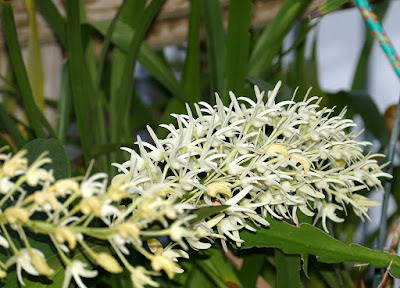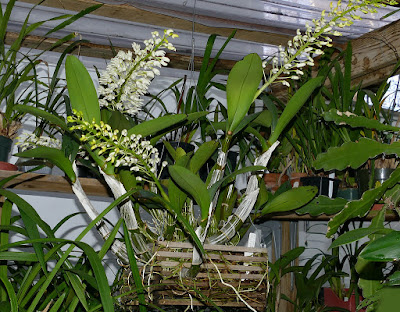Dendrobium speciosum is found in New South Wales and Victoria Australia. It is not only a widespread Australian orchid, but its varieties can be found in varying habitats on branches of rainforest trees or on sandstone in open forest, spread out along the east coast of Australia and in and along the tropic of Capricorn. As a lithophyte, it can produce large spreading clumps on rocks and cliff faces, often in full sun, with its roots forming a dense matt across the rock. It can be found from the coastline to the mountains.
Dendrobium speciosum also called as The Outstanding Dendrobium, Sydney Rock Orchid, Rock Lily, is a species of the genus Dendrobium. This species was described by James Edward Smith in 1804.
IDENTIFY DENDROBIUM SPECIOSUM ORCHID PLANT
Dendrobium speciosum is found in New South Wales and Victoria Australia. It is not only a widespread Australian orchid, but its varieties can be found in varying habitats on branches of rainforest trees or on sandstone in open forest, spread out along the east coast of Australia and in and along the tropic of Capricorn. As a lithophyte, it can produce large spreading clumps on rocks and cliff faces, often in full sun, with its roots forming a dense matt across the rock. It can be found from the coastline to the mountains.
Rock Lily is a small to medium sized, cool to hot growing lithophyte with swollen or clavate, several noded, slightly sulcate stems covered with sheathing bracts and carrying 2 to 5, towards the apex, ovate or oblong, thick, coriaceous, obtuse leaves.
The Outstanding Dendrobium bloom in the spring with fragrant flowers on an erect or pendant, to 45 cm long, many flowered raceme. The flowers are beautiful, being cream to yellow on the outer of the petals and sepals and tending to a reflective white toward the center. The lower petal, the labellum, is attractively spotted with purple.
DENDROBIUM SPECIOSUM ORCHID PLANT CARE AND CULTURE
Cultural information should only be used as a guide, and should be to be adapted to suit you. Your physical location; where you grow your plants, how much time you have to devote to their care, and many other factors, will need to be taken into account. Only then can you decide on the cultural methods that best suit you and your plants.
Light:
Dendrobium speciosum can withstand full sun but to avoid sun damaged leaves it’s best to provide some shading, (50-70% shade) and the more light you give them the more flowers will be produced. They can have full sun in late autumn and winter.
Temperature:
Rock Lily can withstand summer temperatures of 45°C and winter temperatures as low as 0°C providing protection from frosts and some shading from the sun if you want to have unblemished leaves. Frost protection is the most important thing for long-term success with this species. One frosty night can set back your plants for three or four years.
Humidity:
It is important to provide plenty of air movement, if you can provide humidity to Sydney Rock Orchid, it is a bonus but not essential.
Substrate, growing media and repotting:
Dendrobium speciosum are usually grow in pot using bark 15-20mm for large plants and 10-15mm for smaller seedlings mixed with perlite to a ratio of 50/50. Squat pots are used as the plants do not have deep root systems. Repotting is done in spring or in the case the substrate lose its nutrients.
The Outstanding Dendrobium can also be grown in hanging baskets or mounted on boards. When mounting plants they can be secured with wire and the roots covered with sphagnum moss which is held in place by material such as a strip of shade cloth.
Watering:
Watering depends upon the size pot, how large the plant is and also what growing medium is used. Generally water every 3 days in summer for large pots and every 2 days for smaller pots. If you have a very dense potting medium then you would probably water less than that. For spring and autumn, every 5 days, every fortnight in winter, and once again it depends on pot size with smaller pots requiring more frequent watering than larger ones. The number one cause of orchids failing to establish and do well is overwatering as root rot will occur very quickly.
Fertilizer:
The Outstanding Dendrobium should be fertilized periodically with blood and bone (especially in spring and autumn) and a dilute soluble fertilizer applied regularly during the growing season. An inline fertilizer connected to the hose is an effective way of promoting flowering.
Rest period:
Dendrobium speciosum needs a drier winter rest with no fertilizer and reduce watering. Water and fertilizer are back to normal level in spring or when new shoots appears. Even in ideal cultivation conditions it may not flower every year, especially so in plants from more southern populations.















COMMENTS